Table of Contents[Hide][Show]
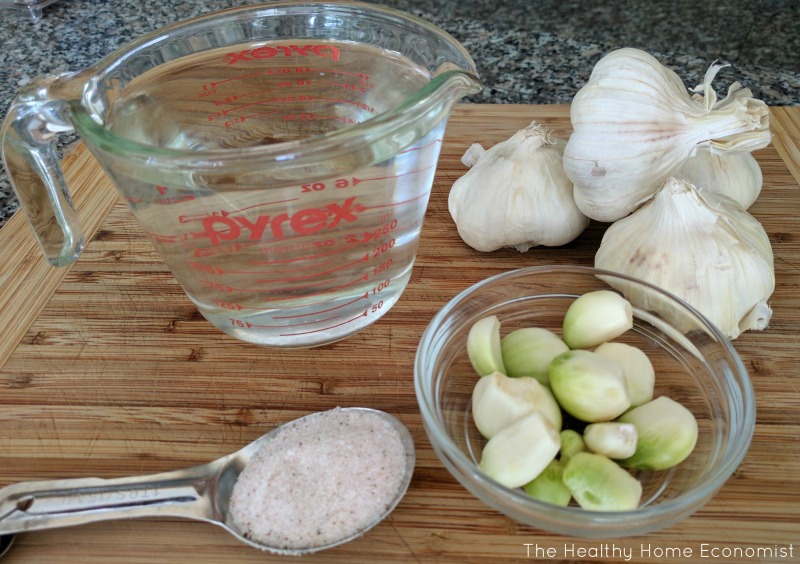
If you peruse the most popular pickled garlic recipes on the internet, nearly every single one contains vinegar and/or sugar. Even more problematic, the instructions frequently suggest using white vinegar and refined white sugar.
Both of these ingredients are almost always GMO frankenfoods at least in North America! The vinegar is derived from glyphosate laced GMO corn and usually the white sugar from Roundup Ready GMO sugarbeets. If you thought the white or brown sugar at the store was pure cane sugar, guess again. Unless the packaging specifically says “cane sugar”, it’s all or partially derived from gut destroying GMO beets.
Even worse (if that’s possible), the recipes suggest cooking the garlic!
Unfortunately, this isn’t the optimal way to go about it – certainly not if you wish to enhance the natural anti-viral, anti-fungal, and antibiotic power of garlic.
Raw garlic is a highly potent weapon for staying healthy. It is effective at fighting, not just pathogenic bacteria. It fights all harmful microbes including viruses and fungi. For this reason alone, it far outperforms synthetic antibiotics for non-life-threatening infections and illnesses when used properly. What’s more, garlic doesn’t harm your beneficial intestinal microbes and unbalance the gut for months or even years afterward as meds do.
Why in the world would you want to destroy all those unmatched benefits by cooking the cloves and then pickling in vinegar and sugar?
The key is to ferment the garlic.
~Fermented vegetables are always pickled, but not all pickled vegetables are fermented~
This article on pickled vs fermented foods contains more information so that you don’t ever get fooled into thinking a pickled food at the store has probiotic value. Check the ingredients. If there’s vinegar and/or sugar listed, don’t buy it.
Benefits of Pickled Garlic
Perhaps the greatest benefits of pickling garlic instead of eating it without fermenting are these:
- The inherent hotness of eating a raw clove is greatly reduced and/or virtually eliminated.
- The icky potential for reeking of garlic on your breath and in your sweat goes bye-bye.
Hence, fermenting garlic eliminates the negative aspects of eating raw garlic without reducing or eliminating any of the natural benefits. In addition, the probiotic and enzymatic value of garlic is enhanced by fermentation.
There just isn’t any reason whatsoever to pickle cooked garlic in vinegar. Unless of course you are a food manufacturer and mass production and supermarket shelf life are of primary concern.
Using Fermented Garlic Therapeutically
I recently gave a talk at my daughter’s school on the immune system. The teacher hosting the class told me that he knows a farmer who eats a raw clove of garlic every day to help ward off illness.
Dr. Natasha Campbell-McBride MD, author of the bestselling book about the GAPS Diet, would concur. In fact, she recommends eating an entire head of garlic per day (one clove every few hours during waking hours) until the illness or infection subsides.
The great thing about having a jar of fermented garlic on hand is that you can easily grab a clove or two whenever you need it. This is reminiscent of having a jar of the Master Tonic in the pantry during cold/flu season.
I like to suck on a clove as a natural remedy for sore throat. While sucking on a raw clove (let alone chewing it) is too hot for many people, sucking on a pickled clove is easy to do. In fact, the flavor is similar to roasted garlic and quite tasty. Thus, fermented garlic cloves are a great option for children over age 3.
As mentioned before, those who are sensitive to raw garlic will likely find pickled garlic to be no problem. The fermentation process conveniently eliminates some of the stinky aspects of the body and breath afterward.
Pickling garlic that is properly fermented is also a frugal alternative to using garlic or allicin supplements. On the positive side, buffered garlic in pill form is very convenient for traveling, so don’t completely discount this as an option on occasion.
Pickled Garlic Recipe
Cori H. of Billings, Montana suggested the wonderfully easy recipe for pickled garlic below. Cori is also the local Weston Price (WAPF) Chapter Leader if you happen to live in that area and would like more local food ideas. You can check out her blog by clicking here.
Green Garlic?
Please note that sometimes pickling garlic will turn slightly greenish or bluish. It is perfectly safe to eat. This is in contrast to white potatoes that are green under the skin, which should be tossed!
Garlic naturally contains beneficial sulfur compounds that can react with the copper in water to form copper sulfate. This is a blue or blue-green compound. The amount of copper needed for this reaction is very small and is frequently found in normal water supplies even when the water is filtered. If you have reverse-osmosis water, you probably won’t experience this while pickling garlic as RO water removes most of the minerals.
The bottom line is as long as the cloves are nestled safely within the brine water, a slight color change isn’t a problem. One of the wonders of fermentation is that each batch can turn out a bit differently!
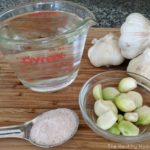
Pickled Garlic
Easy recipe for pickled garlic that will boost the flavor of dishes and can also be used medicinally as a natural antibiotic and anti-viral.
Ingredients
- 5-6 heads of garlic preferably organic
- 1 pint filtered water
- 1 Tbl sea salt
Instructions
-
Separate all the cloves from each head of garlic.
-
Carefully remove the papery skin from each clove.
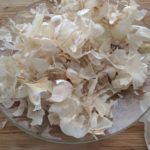
-
Place all the cloves in a mason jar and fill with filtered water mixed with sea salt.
-
Place a fermentation weight on top. This will keep the cloves at the bottom of the jar when the water is added. This is a simpler and more frugal option than expensive Pickl-It jars and anaerobic lids.
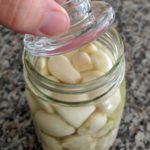
-
Make sure at least 1 inch is left for air at the top of the jar.
-
Close the lid tightly and place in a cool pantry or cabinet for one month. Best to label the lid so you remember when the fermentation began.
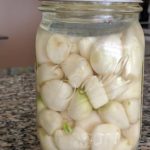
-
After one month, transfer to the refrigerator. Consume the pickled cloves as needed to flavor dishes and as one of the best natural antibiotics.
Recipe Notes
Do not use large elephant garlic, as it does not have the same therapeutic value.
You may wish to check on the pickling garlic every week or so during the month long fermentation. If the water level has decreased, add more brinewater as needed (1 Tbl sea salt per pint of filtered water).
**Open the jar over the sink as the pressure can build up substantially from the fermentation.
If you get sick during the time the garlic is pickling, feel free to dive into those cloves early. They will probably still be a little hot, but they will be highly therapeutic nonetheless.
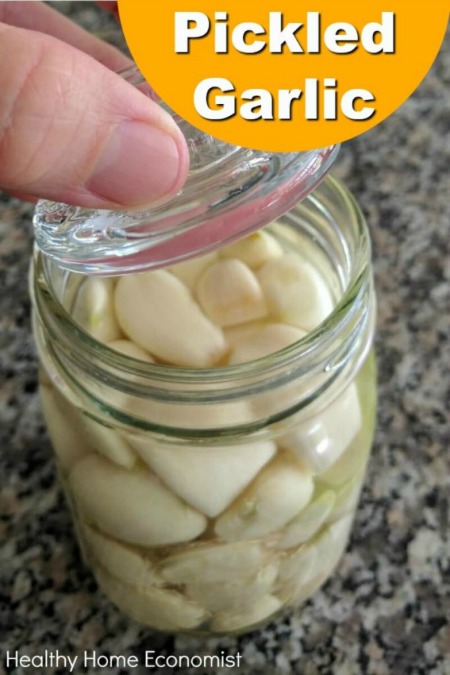








I started the pickled garlic 2 weeks ago. I noticed few days ago they turned bluish/green, that’s fine but I noticed today 2 small sized circular white mould floating on top. I removed it, the garlic is nestled safely under the brine water. Is it safe to eat or I should discard it?
I was looking forward to tasting the garlic. It’s a great recipe.
Any advice would be appreciated.
Thanks
Farah
I put cloves in an empty pickle jar in the pickle water. That ok? Mostly I eat them raw, when my mouth is full of other food, making sure to chew it up good. Been doing one per day, going to up it to 2
I prepare fermented garlic as above and it is a regular part of my diet. One thing I’ve never found a conclusive answer on is whether the fermentation process enables the Alliin to Allicin conversion that is detailed in another blog post on this site. Any thoughts, Sarah?
I haven’t seen any research on it one way or another.
Does the fermentation process greatly change the taste of the garlic? Can you still use it in recipes the same way? Is a month the longest you would let it sit and ferment in the pantry? Is there another way to store and keep garlic beneficially, for longer periods of time.
Fermented raw garlic cloves are not as strong in taste as the fermentation takes out the “heat” a bit without reducing any of the benefits. Some people still find them too hot. Others (like me) find them very tasty!
The other way I use to keep garlic for a long time is via the Master Tonic. https://www.thehealthyhomeeconomist.com/master-tonic-natural-flu-antiviral/
Please, can I use fresh garlic
Yes, that’s what the recipe calls for is fresh cloves.
I wish these recipes would include problems that may happen & if they are concerning & what, if anything to do. I’m in the process of pickling my garlic & as I said the brine has turned cloudy with some icky looking white stuff at the top. Did I do something wrong?
Probably fine. Here’s more on the white stuff on top. https://www.thehealthyhomeeconomist.com/mold-fermented-foods-what-to-do/
I made the pickled garlic 2 weeks ago & have checked it once a week as directed. When I looked at it today, the water is cloudy & a bit ickey on the top. 1 clove escaped the weight. Should I leave it? Or is something wrong? Thank you!
What age is this safe to start giving children? And how many per day when they are sick? I gave my 10 month old A clove chopped Up when she had a virus and she broke out in hives shortly after. Maybe that was dumb on my part… The doctor didn’t think It was related to the garlic but was in relation to the illness. But I know she broke out right after I gave her the garlic. She is 3.5 now and I want to try it again but am scared. I also have a 20 month old and am expecting my third in a few weeks so I would really like some recommendations on timing?
This food is very strong! I thought it was self-evident, but it is not appropriate for babies and young toddlers. I would recommend allicin liquid instead of garlic cloves for children 3-7. This is also inappropriate for children younger than 3. https://amzn.to/2HyGLtM
Use only as directed on the bottle which is half the adult dose per the company Q/A.
I have done 3 batchs of all ready peeled garlic that i buy at costco . The first batch came out perfect. The two batchs afterward started turning brown in the second week and was not very active.I put them in the refridge and i am eating them even though they are not as pickly.Not sure what i did wrong maybe not enough salt.Have you had this happen or anyone else?
Sarah, can you shed any light on this? I tried this recipe and everything went well and then months later, my cloves started turning ‘pinkish’..I kept using them but then they got a little ‘slimy’…which grossed me out. I’m very careful about ‘double-dipping’ and using clean (not always sterile though) untensils. Have you ever ran into this issue? Thanks for any help.
I don’t know what might have happened. My garlic has never turned pink. I would definitely toss them if they were mine. Some dangerous types of mold are bright colored.